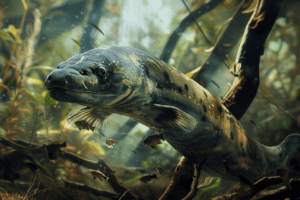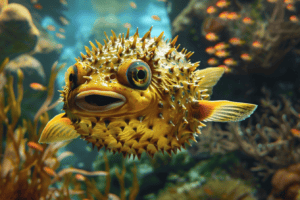The ocean is home to an incredible array of creatures, from the tiniest plankton to the largest whales.
Among these fascinating creatures are frogfish, which are known for their remarkable ability to mimic their surroundings.
These masters of mimicry are some of the most fascinating creatures in the ocean, and they are sure to capture the imagination of anyone who encounters them.

Frogfish are a type of anglerfish that are found in tropical and subtropical waters around the world.
They are known for their distinctive shape, which resembles a lumpy, bumpy rock or piece of coral.
This unique appearance is a key part of their camouflage strategy, as it helps them blend in with their surroundings and avoid detection by predators and prey alike.
Despite their unusual appearance, frogfish are actually quite skilled predators.
They use their fins to walk along the ocean floor, and they have a unique fishing lure on their head that they use to attract prey.
When a fish or other small creature comes too close to the lure, the frogfish strikes with lightning-fast speed, swallowing its prey whole in just a fraction of a second.
With their remarkable camouflage and lightning-fast reflexes, frogfish are truly masters of mimicry and some of the most fascinating creatures in the ocean.
Frogfish Fundamentals
Defining the Frogfish
Frogfish are a type of marine fish that belong to the family Antennariidae.
These unique creatures are known for their remarkable ability to mimic their surroundings, making them masters of camouflage.
They have a stocky, globular body with a large mouth and a lure on top of their head that resembles a worm or small fish.
This lure is used to attract prey by mimicking the movements of potential food sources.
Frogfish come in a variety of colors and patterns, ranging from bright yellow to mottled brown and green.
Some species even have spines or bumps on their skin that further aid in their camouflage.
They range in size from just a few centimeters to over 20 centimeters in length.
Habitat and Distribution
Frogfish can be found in tropical and subtropical waters around the world, from the shallowest coral reefs to depths of over 100 meters.
They are most commonly found in the Indo-Pacific region, but can also be found in the Atlantic and Mediterranean oceans.
Frogfish are typically found hiding in crevices or on the ocean floor, waiting for prey to come within striking distance.
They are most active at night, but can also be seen during the day.
Some species are known to be territorial and will defend their area from other frogfish.
Despite their unique appearance, frogfish are not commonly seen by divers due to their excellent camouflage.
However, they are a favorite among underwater photographers and are highly sought after for their unique and fascinating behavior.
Fun Fact: Frogfish are able to change their color and pattern to match their surroundings in just a matter of weeks, making them one of the most adaptable creatures in the ocean.
Masters of Disguise

Frogfish are true masters of disguise, able to blend seamlessly into their surroundings and become nearly invisible to predators and prey alike.
Their unique camouflage techniques and hunting strategies make them one of the most fascinating creatures in the ocean.
Camouflage Techniques
Frogfish have a remarkable ability to change their skin color and texture to match their surroundings.
They can mimic the color and texture of rocks, coral, sponges, and even other fish.
This camouflage is achieved through specialized skin cells called chromatophores, which contain pigments that can be expanded or contracted to change color.
In addition to color change, frogfish can also alter their skin texture to match their environment.
They have small skin flaps called dermal spinules that can be raised or lowered to create a rough or smooth texture.
This allows them to blend in even more effectively with their surroundings.
Hunting and Diet
Frogfish are ambush predators, lying in wait for their prey to come within striking distance.
They have a unique hunting strategy that involves using a modified dorsal fin as a fishing lure to attract prey.
The lure is shaped like a small fish or shrimp and can be moved independently of the frogfish’s body, making it even more convincing.
Once the prey is close enough, the frogfish will rapidly open its mouth, creating a vacuum that sucks in the unsuspecting victim.
Frogfish have large mouths that can expand to swallow prey larger than themselves, such as small fish and crustaceans.
They are also able to digest their prey quickly, allowing them to consume multiple meals in a short period of time.
In conclusion, frogfish are truly remarkable creatures with incredible camouflage abilities and unique hunting strategies.
Their ability to blend in with their surroundings and lure in their prey make them one of the most fascinating fish in the ocean.
Reproduction and Lifecycle

Mating Rituals
Frogfish are known for their unique mating rituals.
During the breeding season, male frogfish will approach a female and begin to nudge her with his head.
If the female is receptive, she will respond by touching her genital opening to the male’s head.
The male will then release his sperm, which the female will use to fertilize her eggs.
Interestingly, some species of frogfish have been observed engaging in polygamous mating.
In these cases, a single male will mate with multiple females during the breeding season.
Growth and Development
After fertilization, the female frogfish will lay her eggs in a gelatinous mass that is attached to a hard surface, such as a rock or coral reef.
The eggs will hatch into larvae after a few days, which will then drift in the ocean currents for several weeks before settling on the ocean floor.
Once settled, the larvae will undergo metamorphosis and transform into juvenile frogfish.
These young fish will resemble their adult counterparts but will be much smaller in size.
They will continue to grow and develop over the course of several months until they reach maturity.
Fun Fact: Some species of frogfish are known to change their color and pattern to match their surroundings, making them difficult to spot by predators and prey alike.
Conservation Status

Threats to Survival
As with many marine creatures, frogfish populations are under threat from a variety of human activities.
One of the biggest threats to their survival is habitat destruction.
The destruction of coral reefs, mangrove forests, and other important marine habitats can have a devastating impact on frogfish populations.
Pollution, overfishing, and climate change are also major threats to their survival.
Frogfish are often caught accidentally by fishermen targeting other species.
They are also targeted by the aquarium trade, which can put additional pressure on their populations.
In some parts of the world, frogfish are considered a delicacy and are hunted for food.
Conservation Efforts
Efforts are underway to protect frogfish populations and their habitats.
Many countries have established marine protected areas where fishing and other activities are restricted.
These protected areas help to safeguard important habitats and allow populations to recover.
In addition, many organizations are working to raise awareness about the importance of conserving frogfish and other marine species.
They are also working to educate fishermen and other stakeholders about the importance of sustainable fishing practices.
Overall, there is still much work to be done to protect frogfish and other marine species.
By working together, we can help to ensure that these remarkable creatures continue to thrive in our oceans for generations to come.
Fun fact: Did you know that frogfish are sometimes called “anglerfish” because of their ability to lure prey with a fleshy lure on their head that resembles a fishing lure?
Frequently Asked Questions

How do frogfish disguise themselves in their environment?
Frogfish are masters of disguise.
They have the ability to change their color and texture to match their surroundings, making them almost invisible to predators and prey alike.
They can mimic the color and texture of rocks, coral, and even sponges.
They achieve this by using special skin cells called chromatophores, which allow them to change color almost instantly.
What techniques do frogfish use to capture their prey?
Frogfish are ambush predators and use a variety of techniques to capture their prey.
They can lure their prey by using a protrusion on their head called an illicium, which resembles a small fish or worm.
Once the prey gets close enough, the frogfish will suddenly open its mouth and suck in the prey with incredible speed.
They can also use their camouflage to stay hidden and surprise their prey.
Is it safe to touch a frogfish if I see one while diving?
It is not recommended to touch a frogfish if you see one while diving.
They have sharp spines on their fins that can cause injury, and they also have a toxic mucus coating on their skin that can cause skin irritation or even blindness if it gets into your eyes.
It is best to observe them from a safe distance and let them go about their business undisturbed.
What makes frogfish different from other fish in the sea?
Frogfish are unique in many ways. They have a distinctive appearance with a large head, stocky body, and fins that are modified into leg-like structures.
They also have a unique way of swimming, using their modified fins to “walk” along the sea floor.
They are also one of the few fish that can change color and texture to match their surroundings.
How do frogfish contribute to the health of coral reefs?
Frogfish play an important role in the coral reef ecosystem.
They help to control the population of smaller fish and invertebrates, which can prevent overgrazing and damage to the coral.
They also help to maintain the balance of the ecosystem by providing food for larger predators.
What are some of the most surprising facts about frogfish behavior?
Frogfish have many surprising behaviors that make them fascinating to observe.
For example, they have been known to “walk” across the sea floor using their modified fins, and they can also inflate their bodies to appear larger and more intimidating to predators.
They are also known to be quite lazy, often staying in one spot for days or even weeks at a time, waiting for prey to come to them.









